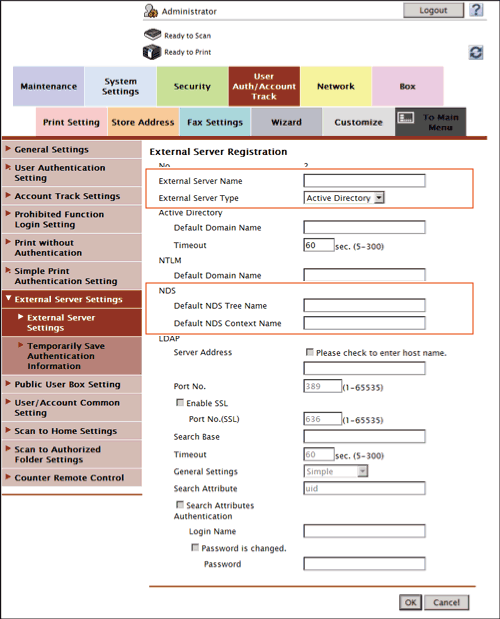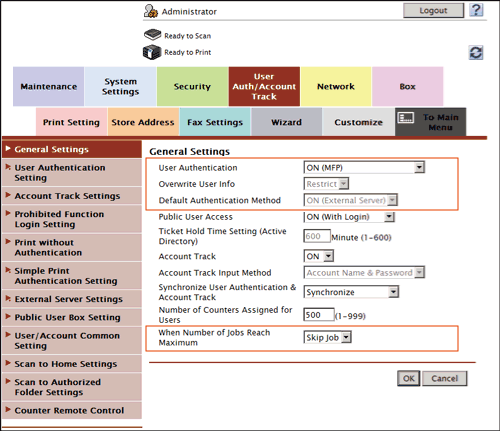
Employing the NDS over TCP/IP Authentication
Overview
When you use NDS (Novell Directory Service) of NetWare 5.1 or later for user management, you can restrict users of this machine by authentication using NDS.
Employing the user authentication enables security- and cost-conscious advanced operations such as restricting users from accessing this machine, restricting users from using the functions by user, and managing the use status of this machine.
This section describes how to use NDS authentication in the TCP/IP environment (NDS over TCP/IP) using NetWare 5.1 or later. Apply the latest service pack to each NetWare version.
When employing the NDS over TCP/IP authentication, follow the below procedure to configure the settings.
- Configure basic settings for the NDS over TCP/IP authentication
- For details on configuring the setting, refer to Here.
- To use the authentication with NDS over TCP/IP, you must register the DNS server. When performing authentication, this machine inquires the DNS server about the tree name and context name to obtain the IP address of the NDS server. For details on how to register the DNS server, refer to Here.
- Set the following options according to your environment
Purpose Reference Send original data scanned by this machine easily to the login user's own address using E-mail (Scan to Me).Construct a single sign-on environment for the SMB transmissionRestrict available functions by userRestrict the access to destinations by userChange function keys displayed in the Touch Panel by userSpecify the operations of the ID & Print functionSpecify how to manage color printing and operations of this machine when you log outRestrict print jobs without authentication informationPrint data from the printer driver without using the password
Configuring basic settings for the NDS over TCP/IP authentication
Register your authentication server on this machine. In addition, change the authentication method of this machine so that authentication is performed using the registered authentication server.
- In the administrator mode, select [User Auth/Account Track] - [External Server Settings] - [Edit], then configure the following settings.

Settings Description [External Server Name]Enter the name of your NDS server (using up to 32 characters).Assign an easy-to-understand name to the NDS server to be registered.[External Server Type]Select [NDS over TCP/IP].[Default NDS Tree Name]Enter the default NDS tree name (using up to 63 characters).[Default NDS Context Name]Enter the default NDS context name (using up to 191 characters). - In the administrator mode, select [User Auth/Account Track] - [General Settings], then configure the following settings.

Settings Description [User Authentication]When performing authentication using an external authentication server, select [ON (External Server)] or [ON (MFP + External Server)].If you want to configure setting so that you can log in to this machine using its authentication function in consideration of an occurrence of some sort of problem on the external authentication server, select [ON (MFP + External Server)].[Overwrite User Info]When the external server authentication is used, authenticated user information is also managed on this machine. If the number of users who have executed the external server authentication reaches the maximum number of users this machine can manage, authentication of any new users will not be permitted. Select whether to allow the user to overwrite registered user information for that case.If you select [Allow], the oldest authenticated user information is erased and the new user is registered.[Restrict] is specified by default.[Default Authentication Method]If you have selected [ON (MFP + External Server)] at [User Authentication], select the authentication method you use normally.[ON (External Server)] is specified by default.[When Number of Jobs Reach Maximum]Sets the maximum number of sheets that each user can print. Here, select an operation if the number of sheets exceeds the maximum number of sheets that can be printed.- [Skip Job]: Stops the job currently running, and starts printing the next job.
- [Stop Job]: Stops all jobs.
[Skip Job] is specified by default. - If you select [ON (MFP + External Server)] in Step 2, select [User Auth/Account Track] - [External Server Settings] - [Temporarily Save Authentication Information] in the administrator mode, and configure the following settings.

Settings Description [Temporarily Save Authentication Information]To temporarily save authentication information in the main unit against a case where an external authentication server shuts down, select [Enable].[Disable] is specified by default.[Reconnection Settings]If necessary, change the time to reconnect to the authentication server.- [Reconnect for every login]: Connects to the authentication server at the time authentication is carried out on this machine. If the authentication server is in the shutdown state at the time authentication is carried out on this machine, first confirm that the authentication server is down, and use the temporarily saved authentication information to log in to this machine.
- [Set Reconnect Interval]: Connect to the authentication server at the time specified in [Reconnection Time], and check the status of the authentication server. If the authentication server is in the shutdown state, use the authentication information temporarily saved in the main unit to log in.
[Set Reconnect Interval] is specified by default.